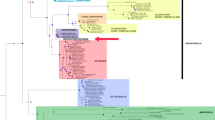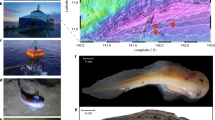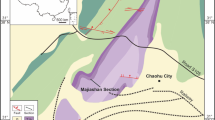Abstract
The discovery of four new Xenoturbella species from deep waters of the eastern Pacific Ocean is reported here. The genus and two nominal species were described from the west coast of Sweden1,2, but their taxonomic placement remains unstable3,4. Limited evidence placed Xenoturbella with molluscs5,6, but the tissues can be contaminated with prey7,8. They were then considered deuterostomes9,10,11,12,13. Further taxon sampling and analysis have grouped Xenoturbella with acoelomorphs (=Xenacoelomorpha) as sister to all other Bilateria (=Nephrozoa)14,15, or placed Xenacoelomorpha inside Deuterostomia with Ambulacraria (Hemichordata + Echinodermata)16. Here we describe four new species of Xenoturbella and reassess those hypotheses. A large species (>20 cm long) was found at cold-water hydrocarbon seeps at 2,890 m depth in Monterey Canyon and at 1,722 m in the Gulf of California (Mexico). A second large species (~10 cm long) also occurred at 1,722 m in the Gulf of California. The third large species (~15 cm long) was found at ~3,700 m depth near a newly discovered carbonate-hosted hydrothermal vent in the Gulf of California. Finally, a small species (~2.5 cm long), found near a whale carcass at 631 m depth in Monterey Submarine Canyon (California), resembles the two nominal species from Sweden. Analysis of whole mitochondrial genomes places the three larger species as a sister clade to the smaller Atlantic and Pacific species. Phylogenomic analyses of transcriptomic sequences support placement of Xenacoelomorpha as sister to Nephrozoa or Protostomia.
This is a preview of subscription content, access via your institution
Access options
Subscribe to this journal
Receive 51 print issues and online access
$199.00 per year
only $3.90 per issue
Buy this article
- Purchase on Springer Link
- Instant access to full article PDF
Prices may be subject to local taxes which are calculated during checkout



Similar content being viewed by others
Accession codes
Data deposits
Sequence data have been deposited in GenBank; accession numbers can be found in Supplementary Tables 3–5.
References
Westblad, E. Xenoturbella bocki n.g., n.sp. a peculiar, primitive turbellarian type. Ark. Zool. 1, 11–29 (1949)
Israelsson, O. New light on the enigmatic Xenoturbella (phylum uncertain): ontogeny and phylogeny. Proc. R. Soc. Lond. B 266, 835–841 (1999)
Reisinger, E. Was ist Xenoturbella? Z. Wiss. Zool. 164, 188–198 (1960)
Nakano, H. What is Xenoturbella? Zool. Lett. 1, 22 (2015)
Norén, M. & Jondelius, U. Xenoturbella’s molluscan relatives... . Nature 390, 31–32 (1997)
Israelsson, O. …and molluscan embryogenesis. Nature 390, 32 (1997)
Bourlat, S. J., Nielsen, C., Lockyer, A. E., Littlewood, D. T. J. & Telford, M. J. Xenoturbella is a deuterostome that eats molluscs. Nature 424, 925–928 (2003)
Bourlat, S. J. et al. Feeding ecology of Xenoturbella bocki (phylum Xenoturbellida) revealed by genetic barcoding. Mol. Ecol. Resour. 8, 18–22 (2008)
Bourlat, S. J. et al. Deuterostome phylogeny reveals monophyletic chordates and the new phylum Xenoturbellida. Nature 444, 85–88 (2006)
Bourlat, S. J., Nielsen, C., Economou, A. D. & Telford, M. J. Testing the new animal phylogeny: a phylum level molecular analysis of the animal kingdom. Mol. Phylogenet. Evol. 49, 23–31 (2008)
Dunn, C. W. et al. Broad phylogenomic sampling improves resolution of the animal tree of life. Nature 452, 745–749 (2008)
Bourlat, S. J., Rota-Stabelli, O., Lanfear, R. & Telford, M. J. The mitochondrial genome structure of Xenoturbella bocki (phylum Xenoturbellida) is ancestral within the deuterostomes. BMC Evol. Biol. 9, 107 (2009)
Telford, M. J., Budd, G. E. & Philippe, H. Phylogenomic insights into animal evolution. Curr. Biol. 25, R876–R887 (2015)
Hejnol, A. et al. Assessing the root of bilaterian animals with scalable phylogenomic methods. Proc. R. Soc. B 276, 4261–4270 (2009)
Ryan, J. F. et al.; NISC Comparative Sequencing Program. The genome of the ctenophore Mnemiopsis leidyi and its implications for cell type evolution. Science 342, 1242592 (2013)
Philippe, H. et al. Acoelomorph flatworms are deuterostomes related to Xenoturbella . Nature 470, 255–258 (2011)
Israelsson, O. & Budd, G. E. Eggs and embryos in Xenoturbella (phylum uncertain) are not ingested prey. Dev. Genes Evol. 215, 358–363 (2005)
Perseke, M. et al. The mitochondrial DNA of Xenoturbella bocki: genomic architecture and phylogenetic analysis. Theory Biosci. 126, 35–42 (2007)
Lartillot, N., Lepage, T. & Blanquart, S. PhyloBayes 3: a Bayesian software package for phylogenetic reconstruction and molecular dating. Bioinformatics 25, 2286–2288 (2009)
Stamatakis, A. RAxML version 8: a tool for phylogenetic analysis and post-analysis of large phylogenies. Bioinformatics 30, 1312–1313 (2014)
Church, S. H., Ryan, J. F. & Dunn, C. W. Automation and evaluation of the SOWH Test with SOWHAT. Syst. Biol. 64, 1048–1058 (2015)
Mirarab, S. & Warnow, T. ASTRAL-II: coalescent-based species tree estimation with many hundreds of taxa and thousands of genes. Bioinformatics 31, i44–i52 (2015)
Whelan, N. V., Kocot, K. M., Moroz, L. L. & Halanych, K. M. Error, signal, and the placement of Ctenophora sister to all other animals. Proc. Natl Acad. Sci. USA 112, 5773–5778 (2015)
Dunn, C. W., Giribet, G., Edgecombe, G. D. & Hejnol, A. Animal phylogeny and Its evolutionary implications. Annu. Rev. Ecol. Evol. Syst. 45, 371–395 (2014)
Cannon, J. T. et al. Xenacoelomorpha is the sister group to Nephrozoa. Nature http://dx.doi.org/10.1038/nature16520 (this issue)
Miller, M. A., Pfeiffer, W. & Schwartz, T. Creating the CIPRES Science Gateway for inference of large phylogenetic trees. In Proc. Gateway Computing Environments Workshop (GCE), 14 November 2010, New Orleans, LA, 1–8 (IEEE, 2010)
Barry, J. P. & Kochevar, R. E. Calyptogena diagonalis, a new vesicomyid bivalve from subduction zone cold seeps in the Eastern North Pacific. Veliger 42, 117–123 (1999)
Kearse, M. et al. Geneious Basic: an integrated and extendable desktop software platform for the organization and analysis of sequence data. Bioinformatics 28, 1647–1649 (2012)
Koressaar, T. & Remm, M. Enhancements and modifications of primer design program Primer3. Bioinformatics 23, 1289–1291 (2007)
Boore, J. L. & Brown, W. M. Mitochondrial genomes of Galathealinum, Helobdella, and Platynereis: sequence and gene arrangement comparisons indicate that Pogonophora is not a phylum and Annelida and Arthropoda are not sister taxa. Mol. Biol. Evol. 17, 87–106 (2000)
Folmer, O., Black, M., Hoeh, W., Lutz, R. & Vrijenhoek, R. DNA primers for amplification of mitochondrial cytochrome c oxidase subunit I from diverse metazoan invertebrates. Mol. Mar. Biol. Biotechnol. 3, 294–299 (1994)
von Nickisch-Rosenegk, M., Brown, W. M. & Boore, J. L. Complete sequence of the mitochondrial genome of the tapeworm Hymenolepis diminuta: gene arrangements indicate that Platyhelminths are Eutrochozoans. Mol. Biol. Evol. 18, 721–730 (2001)
Clement, M., Posada, D. & Crandall, K. A. TCS: a computer program to estimate gene genealogies. Mol. Ecol. 9, 1657–1659 (2000)
Katoh, K. & Toh, H. Recent developments in the MAFFT multiple sequence alignment program. Brief. Bioinform. 9, 286–298 (2008)
Castresana, J. Selection of conserved blocks from multiple alignments for their use in phylogenetic analysis. Mol. Biol. Evol. 17, 540–552 (2000)
Dunn, C. W., Howison, M. & Zapata, F. Agalma: an automated phylogenomics workflow. BMC Bioinformatics 14, 330 (2013)
Grabherr, M. G. et al. Full-length transcriptome assembly from RNA-Seq data without a reference genome. Nature Biotechnol. 29, 644–652 (2011)
Goldman, N., Anderson, J. P. & Rodrigo, A. G. Likelihood-based tests of topologies in phylogenetics. Syst. Biol. 49, 652–670 (2000)
Acknowledgements
We thank the crew of the R/V Western Flyer and pilots of the ROVs Tiburon and Doc Ricketts for their skill and patience during hunts for these ‘purple socks’. We also thank S. Johnson for verifying bivalve sequences obtained from Xenoturbella and L. Lundsten for hunting through many video files for imagery. We acknowledge the Cyberinfrastructure for Phylogenetic Research (CIPRES) Science Gateway26 for computing resources, and thank M. Miller for additional resources, S. Mirarab for discussions on species tree methods and N. Holland for comments on the manuscript. This work was supported by the David and Lucile Packard Foundation via the Monterey Bay Aquarium Research Institute, Scripps Institution of Oceanography and the National Science Foundation Assembling the Tree of Life program (DEB1036368 to G.W.R.).
Author information
Authors and Affiliations
Contributions
G.W.R., N.G.W. and R.C.V. collected the specimens. N.G.W. and J.I.C. generated and assembled mitochondrial data for the new Xenoturbella species. J.I.C. generated the Xenoturbella Illumina transcriptome and assembled the data. G.W.R. and J.I.C. performed phylogenetic analyses of mitochondrial genomes and transcriptome data. G.W.R. analysed the morphology of Xenoturbella spp. for the taxonomic descriptions. G.W.R. drafted the paper with J.I.C., N.G.W. and R.C.V. All authors commented on the manuscript.
Corresponding author
Ethics declarations
Competing interests
The authors declare no competing financial interests.
Extended data figures and tables
Extended Data Figure 1 X. monstrosa sp. nov.
a, Photograph taken by ROV of a vesicomyid clam field at ~3,000 m depth, Monterey Bay, California. Most clams are E. extenta. Two specimens of Xenoturbella are visible (arrows). Scale bar estimated from size of E. extenta (5 cm average width). b, Supplementary Video 1 frame grab showing same clam field as a with A. diagonalis (Ad) and E. extenta clams. Numerous Xenoturbella (arrows) were observed, including two specimens sampled for this study. Scale bar estimated from size of E. extenta (5 cm average width). c, Ventral view of the holotype SIO-BIC BI1037. Although highly contracted and incomplete (the posterior end was removed and frozen and the ventral area removed for histology), the specimen is still over 10 cm long. The mouth (m), ring furrow (rf) and side furrow (sf) are visible. d, Frame grab of paratype SIO-BIC BI1039, a female in situ. e, Dorsal view of paratype SIO-BIC BI1039 (relaxed) showing ring furrow (rf), side furrow (sf), oocytes in body wall (oo) and part of the ventral surface (v). f, Ventral view of paratype SIO-BIC BI1039 showing the mouth (m), ring furrow (rf), oocytes in body wall (oo) and part of the epidermal ventral glandular network (vgn). g, Close-up of the ventral posterior of paratype SIO-BIC BI1039 showing the trailing off of the ventral glandular network (vgn) and oocytes clearly visible in the body wall. h, Close-up of the ventral anterior of paratype SIO-BIC BI1039 showing the mouth (m), ring furrow (rf) and the beginning of the ventral glandular network (vgn) near the anterior tip of the animal.
Extended Data Figure 2 X. churro sp. nov.
a, Frame grab of holotype SIO-BIC BI1040, a female, from the Guaymas Transform Fault, Gulf of California, Mexico, at ~1,700 m depth in situ. The ring furrow (rf) is visible towards the anterior end. b, Ventral view of the holotype SIO-BIC BI1040, (relaxed) showing mouth (m), ring furrow (rf), oocytes (oo), side furrow (sf) and epidermal ventral glandular network (vgn). Part of the dorsal side (d) is visible. c, Dorsal view of paratype SIO-BIC BI1039 showing ring furrow (rf) and oocytes (oo). d, Close-up of the ventral posterior of the holotype, showing the trailing off of the ventral glandular network (vgn), oocytes and the distinctively tapering posterior tip. e, Close-up of the anterior end of the holotype, showing the mouth (m), ring furrow (rf) and the beginning of the ventral glandular network (vgn) near the anterior tip of the animal.
Extended Data Figure 3 X. profunda sp. nov.
a, Frame grab of paratype SIO-BIC BI1044, a female, from the Pescadero Basin, Gulf of California, Mexico, at ~3,700 m depth in situ. The ring furrow (rf) is visible towards the anterior end. b, Ventral view of the holotype SIO-BIC BI1041, a male (relaxed) showing mouth (m), ring furrow (rf), side furrow (sf) and epidermal ventral glandular network (vgn). c, Dorsal view of the holotype showing the ring furrow (rf). The ventral glandular network (vgn) is visible where part of the ventral side is exposed. d, Close-up of the ventral anterior end of female paratype SIO-BIC BI1044, showing mouth (m), ring furrow (rf), side furrow (sf) and beginning of ventral glandular network (vgn) near the anterior tip of the animal. e, Close-up of the dorsal posterior of female paratype SIO-BIC BI1044, showing oocytes of different sizes distributed in the parenchyma. f, Parasagittal section (1 μm, stained with toluidine blue) through dorsal body of female paratype SIO-BIC BI1044 showing thick epidermis (e), subepidermal nerve net (n), basal lamina (bl), circular muscle layer (cm), longitudinal muscle layer (lm) and parenchyma with oocytes of various sizes (oo). The gastrodermis is not shown here. g, Parasagittal section (1 μm, stained with toluidine blue) through dorsal body wall of the male holotype SIO-BIC BI1041. Tissue layers as in the female, but a layer of developing (sp.) and mature sperm (s) instead of oocytes is present. The gastrodermis (g) lies beneath the parenchyma layer. h, Parasagittal section (1 μm, stained with toluidine blue) showing parenchyma layer with late spermatids or mature sperm with spherical heads and free flagella.
Extended Data Figure 4 X. hollandorum sp. nov.
a, Dorsal view of the live unrelaxed holotype SIO-BIC BI1036, showing ring furrow (rf). b, Ventral view of the holotype (relaxed) showing mouth (m), ring furrow (rf) side furrow (sf) and epidermal ventral glandular network (vgn). c, Close-up of the anterior end of the holotype, showing mouth (m), ring furrow (rf), side furrow (sf) and the ventral glandular network (vgn) near the anterior tip of the animal. d, Close-up of the diamond-shaped mouth.
Extended Data Figure 5 Mitochondrial COI haplotype networks.
a, X. bocki and X. westbladi haplotypes (GenBank accession numbers indicated). Sequences from the two nominal species are completely interconnected. This network suggests that there is only one species in Swedish waters, which should be recognized under the older name, X. bocki. b, X. monstrosa from Monterey Bay (California) and Gulf of California (Mexico) (SIO-BIC accession numbers indicated). c, X. profunda from the vicinity of a hydrothermal vent at 3,700 m in the Pescadero Basin, Mexico (SIO-BIC and UNAM specimens indicated). Holotypes are designated with asterisks in the figure. Networks generated with TCS33.
Extended Data Figure 6 Mitochondrial genomics of Xenoturbella.
a, Gene order for the four new species compared with that of X. bocki9,18. The gene order was consistent across all species with only minor variation in amino acids and length of the control region (also see Supplementary Table 1).
Extended Data Figure 7 Maximum likelihood phylogeny based on all 13 mitochondrial proteins.
Five Xenoturbella species formed a weakly supported sister clade to Acoela = Xenacoelomorpha. Xenacoelomorpha was sister to deuterostomes with weak support. Data were partitioned and analysed using RAxML and GTR + Γ. Analysis using PhyloBayes under CAT + GTR + Γ placed Xenacoelomorpha inside deuterostomes as a weakly supported sister group to Chordata (not shown), a result not recovered previously16 with the same program, model and terminals (except for X. profunda). Scale bar, substitutions per amino-acid position. The lower support for Xenacoelomorpha in its placement with deuterostomes, or its placement with Chordata, compared with previously shown, may be due to additional Xenoturbella data and/or the fact that all 13 mitochondrial proteins were used here.
Extended Data Figure 8 Species tree based on 393 gene trees using Astral II22.
Nodal support assessed via 100 pseudo-replicates of bootstrapping for each gene, combining both information from each gene tree and its respective bootstrap replicates. B, Bilateria; N, Nephrozoa.
Extended Data Figure 9 PhyloBayes analysis of 1,178 genes with 70% average gene occupancy.
CAT + GTR + Γ was used and the first 2,000 out of 4,460 generations for two chains were discarded as burn-in and the remainder used to generate a consensus tree. Scale bar, substitutions per amino-acid position. The largest discrepancy observed between chains was 0.164609 and the mean was 0.000989. Xenacoelomorpha grouped with protostomes. B, Bilateria.
Extended Data Figure 10 Maximum likelihood analyses of ‘fast’- and ‘slow’-evolving data sets.
The 70% occupancy data set was reduced to 1,127 genes (51 ribosomal proteins removed) and then divided into the fastest-evolving 50% and the slowest-evolving 50%. These were analysed using the PROTGAMMAGTR amino-acid substitution model in RAxML. a, Phylogeny based on the ‘fast-evolving’ data set with 216,066 amino acids. b, Phylogeny based on the ‘slow-evolving’ data set with 168,571 amino acids. Nodal support assessed via 100 pseudo-replicates of bootstrapping. Asterisks indicate 100% bootstrap support. B, Bilateria; N, Nephrozoa.
Supplementary information
Supplementary Information
This zipped file contains Supplementary Tables 1-5 and a Supplementary Table guide. (ZIP 310 kb)
Clam field at ~3,000 metres depth Monterey Bay, California.
ROV Tiburon dive 610, October 25, 2004. Collection of a X. monstrosa specimen (type) and images of other Xenoturbella in a field of vesicomyids (mainly Archivesica diagonalis in this clip). (MOV 17448 kb)
Near Pinkie’s Vent at ~1,700 m depth, a cold-water seep in the Guaymas Transform Fault, Gulf of California, Mexico.
ROV Doc Ricketts dive 385, April 13, 2012. The Mexican paratype of X. monstrosa is shown initially followed by the holotype of X. churro and then the collection of both specimens. (MOV 27879 kb)
Sediment near a hydrothermal vent at ~3,700 metres in the Pescadero Basin, Gulf of California, Mexico.
ROV Doc Ricketts dive 757, April 24, 2015. The video shows the female paratype of X. profunda gliding over the sediment in an S-pattern amongst polynoid scaleworms, sea anemones and vesicomyid clams. The video is speeded up to x6 times. (MP4 17706 kb)
Rights and permissions
About this article
Cite this article
Rouse, G., Wilson, N., Carvajal, J. et al. New deep-sea species of Xenoturbella and the position of Xenacoelomorpha. Nature 530, 94–97 (2016). https://doi.org/10.1038/nature16545
Received:
Accepted:
Published:
Issue Date:
DOI: https://doi.org/10.1038/nature16545
This article is cited by
-
Induced spawning with gamete release from body ruptures during reproduction of Xenoturbella bocki
Communications Biology (2023)
-
Mixotrophic chemosynthesis in a deep-sea anemone from hydrothermal vents in the Pescadero Basin, Gulf of California
BMC Biology (2021)
-
The sperm of Xenacoelomorpha revisited: implications for the evolution of early bilaterians
Zoomorphology (2019)
-
The digestive system of xenacoelomorphs
Cell and Tissue Research (2019)
Comments
By submitting a comment you agree to abide by our Terms and Community Guidelines. If you find something abusive or that does not comply with our terms or guidelines please flag it as inappropriate.



